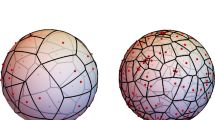Abstract
The classic Voronoi cells can be generalized to a higher order version by considering the cells of points for which a given k-element subset of the set of sites consists of the k closest sites. We study the structure of the k-order Voronoi cells and illustrate our theoretical findings with a case study of two-dimensional higher order Voronoi cells for four points.











Similar content being viewed by others
References
Shamos, M., Hoey, D.: Closest-point problems. In: 16th Annual Symposium on Foundations of Computer Science (sfcs 1975) pp. 730–743 (1975)
Papadopoulou, E., Zavershynskyi, M.: On higher order Voronoi diagrams of line segments. In: Algorithms and computation, Lecture Notes in Comput. Sci., vol. 7676, pp. 177–186. Springer, Heidelberg (2012)
Goberna, M.A., Martínez-Legaz, J.E., Vera de Serio, V.N.: The Voronoi inverse mapping. Linear Algebra Appl. 504, 248–271 (2016)
Mallozzi, L., Puerto, J.: The geometry of optimal partitions in location problems. Optim. Lett. 12(1), 203–220 (2018)
Gemsa, A., Lee, D.T., Liu, C.H., Wagner, D.: Higher order city Voronoi diagrams. In: Algorithm Theory—SWAT 2012, Lecture Notes in Comput. Sci., vol. 7357, pp. 59–70. Springer, Heidelberg (2012)
Kaplan, H., Mulzer, W., Roditty, L., Seiferth, P., Sharir, M.: Dynamic planar Voronoi diagrams for general distance functions and their algorithmic applications. In: Proceedings of the Twenty-Eighth Annual ACM-SIAM Symposium on Discrete Algorithms, pp. 2495–2504. SIAM, Philadelphia, PA (2017)
Klein, R.: Abstract Voronoĭ diagrams and their applications (extended abstract). In: Computational geometry and its applications (Würzburg, 1988), Lecture Notes in Comput. Sci., vol. 333, pp. 148–157. Springer, New York (1988)
O’Neil, P., Wanner, T.: Analyzing the squared distance-to-measure gradient flow system with k-order Voronoi diagrams. Discrete Comput. Geom. 61, 91–119 (2018)
Qiu, C., Shen, H., Chen, K.: An energy-efficient and distributed cooperation mechanism for\(k\)-coverage hole detection and healing in wsns. IEEE Trans. Mob. Comput. 17(6), 1247–1259 (2018)
Giansiracusa, N., Ricciardi, C.: Spatial analysis of U.S. Supreme Court 5-to-4 decisions (2018)
Kolahdouzan, M., Shahabi, C.: Voronoi-based k nearest neighbor search for spatial network databases. In: Proceedings of the Thirtieth International Conference on Very Large Data Bases—Volume 30, VLDB ’04, pp. 840–851. VLDB Endowment (2004)
Goberna, M.A., López, M.A.: Linear Semi-infinite Optimization, Wiley Series in Mathematical Methods in Practice, vol. 2. Wiley, Chichester (1998)
Goberna, M.A., Lopez, M.A., Todorov, M.: Stability theory for linear inequality systems. SIAM J. Matrix Anal. Appl. 17(4), 730–743 (1996)
Zavershynskyi, M., Papadopoulou, E.: A sweepline algorithm for higher order Voronoi diagrams. In: 2013 10th International Symposium on Voronoi Diagrams in Science and Engineering, pp. 16–22 (2013)
Acknowledgements
We are grateful to the two referees for their thoughtful and thorough corrections and suggestions, including the proof of Proposition 3.10. These corrections have greatly improved the quality of our paper. The first author was supported by the MINECO of Spain, Grant MTM2014-59179-C2-2-P, and the Severo Ochoa Programme for Centres of Excellence in R&D [SEV-2015-0563]. He is affiliated to MOVE (Markets, Organizations and Votes in Economics). He thanks The School of Mathematics and Statistics of UNSW Sydney for sponsoring a visit to Sidney to complete this work. The second author is grateful to the Australian Research Council for continuous financial support via grants DE150100240 and DP180100602, which in particular sponsored a trip to Barcelona that initiated this collaboration. The third author was partially supported by MINECO of Spain and ERDF of EU, Grant MTM2014-59179-C2-1-P, and Sistema Nacional de Investigadores, Mexico.
Author information
Authors and Affiliations
Corresponding author
Additional information
Publisher's Note
Springer Nature remains neutral with regard to jurisdictional claims in published maps and institutional affiliations.
Rights and permissions
About this article
Cite this article
Martínez-Legaz, J.E., Roshchina, V. & Todorov, M. On the Structure of Higher Order Voronoi Cells. J Optim Theory Appl 183, 24–49 (2019). https://doi.org/10.1007/s10957-019-01555-2
Received:
Accepted:
Published:
Issue Date:
DOI: https://doi.org/10.1007/s10957-019-01555-2




